A Group Day Tour in North Norfolk today. After the morning mist burnt back, it was bright and warm with some sunny intervals this morning. It clouded over a bit more in the afternoon, and there looked to be some showers to the west of us later on, but it stayed largely dry where we were.
We started this morning with a walk along the coast path at Stiffkey. The weather was not ideal for drift migrants arriving from the continent, but with a light SE wind overnight and mist this morning it was not impossible something might have dropped in. Scanning from the car park revealed a Spoonbill preening out on the saltmarsh which we got the scopes on for a closer look, before it flew off west.
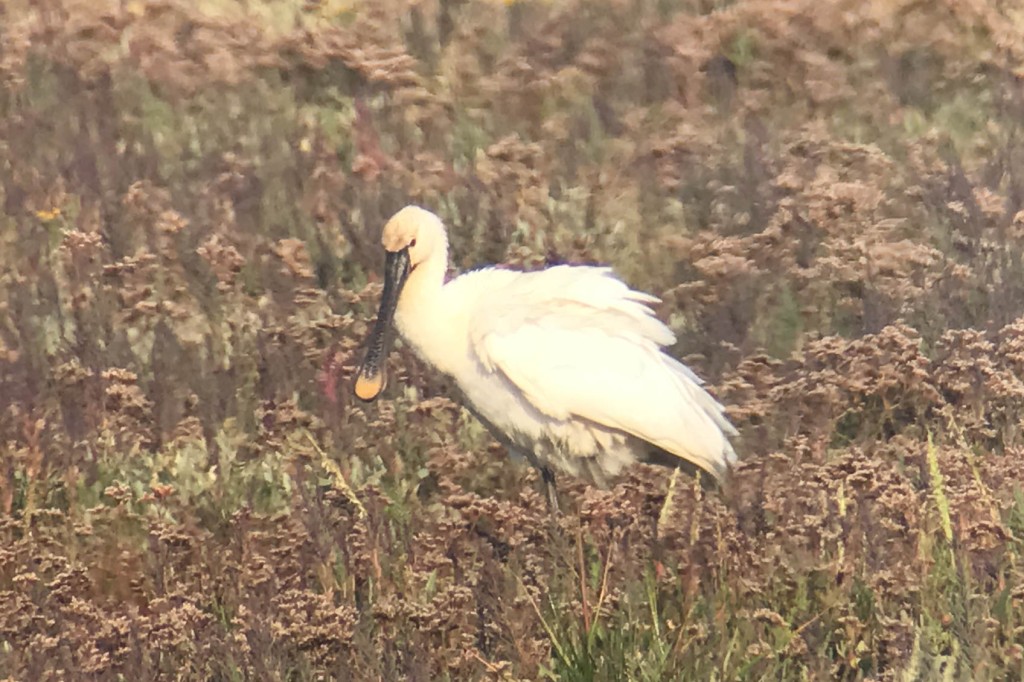
We hadn’t got much further when the bushes by the path were suddenly full of birds – as well as a couple of Blue Tits, there were several Dunnocks, Robin, Goldfinches, Chaffinch and Greenfinch. There didn’t seem to be anything more unusual with them, so we continued on. A Sparrowhawk flew past and disappeared back into Campsite Wood.
There were lots of waders out on the saltmarsh – lots of Curlews and several Redshanks – plus a good number of Little Egrets. A Great Black-backed Gull flew in and flushed a small group of Golden Plover from the vegetation out towards the beach. A single Common Snipe flew in high over the saltmarsh calling, and we lost it in the sun as it headed inland behind us. Another Spoonbill flew over heading east.
We came across a single Blackcap before the whirligig, but the bushes there were rather quiet today. There were one or two butterflies out, enjoying the morning sunshine, a couple of very fresh Commas and a Red Admiral.
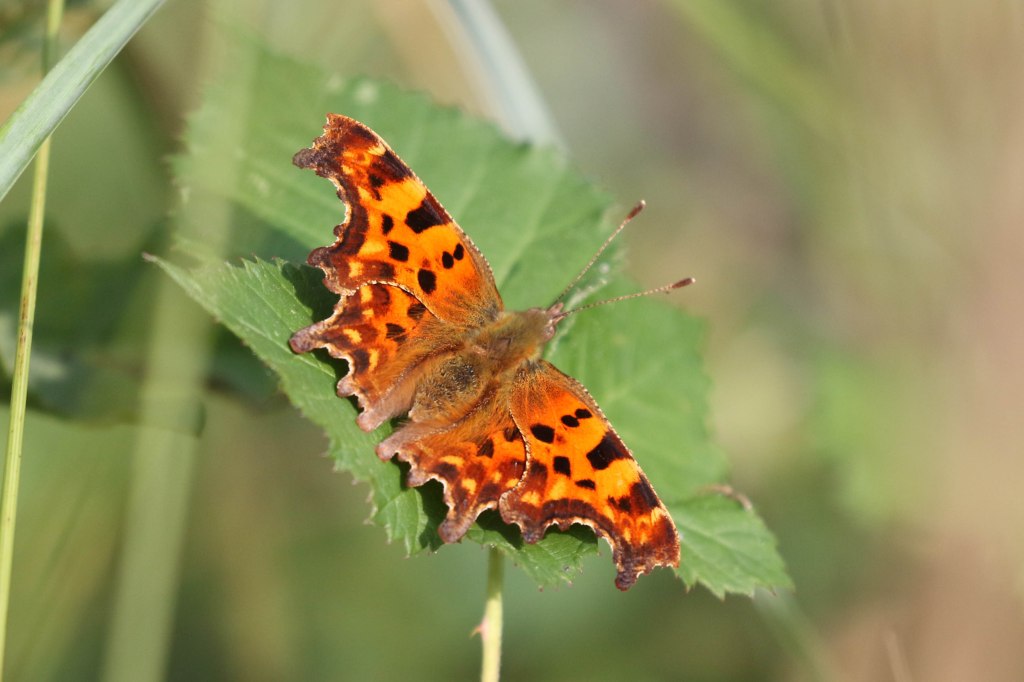
From the far end of the circular path, we stopped again to scan the saltmarsh. More Golden Plover were very well camouflaged, hiding in the vegetation, unless they moved. A single Grey Plover flew round in the distance, flashing its black armpits. A distant Grey Heron and a Common Buzzard were the first of each for the day.
There had been three or four House Martins over the saltmarsh when we arrived, but now a big flock of 30 or more hirundines came through, heading west. Mostly Swallows, there were a few House Martins in with them. Presumably migrants heading off on their way to Africa for the winter. A Siskin flew over very high, calling, probably another migrant.
Looking behind us, we had a quick glimpse of a Lesser Whitethroat in the bushes just beyond the whirligig so we went round for a look. On our way, we flushed a Common Whitethroat from the edge of the tarmac path which landed briefly in a briar, and then when we got out the other side, we found the Lesser Whitethroat again. We had a good view of it for a minute or so out in the open in the elders and hawthorns.. There were a few Blackcaps in here too.
There didn’t seem to be a lot of freshly arrived migrants here, so we decided to head back and try somewhere else. We drove back towards Wells and stopped at the pools just east of town. As we drove down the track, we could see a couple of partridges in the stubble, so we looked round behind the hedge and could see orange faces and grey necks looking out – a small covey of Grey Partridges.
We stood with our scopes on the edge of our field to scan the pool to the east. A Meadow Pipit flew up from the stubble and landed on the fence. Then we noticed a female Yellowhammer a bit further back. Both kept dropping down into the edge of the stubble. A Wheatear popped up onto the fence too – just a few fence posts back from us, and posing nicely, a great view.
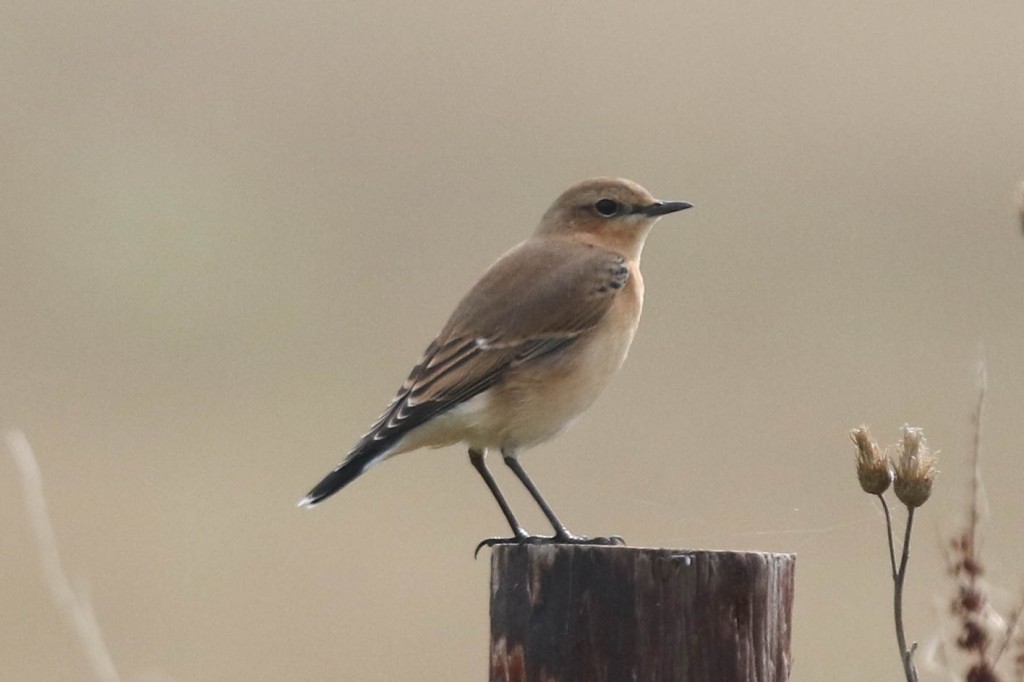
There were four more Spoonbills out in the water towards the back, in amongst the Greylag Geese. There were lots of Wigeon out there too, the drakes all still in rusty eclipse plumage. Three Pintail flew in high from the direction of Wells. A couple of juvenile Shelducks were feeding on the mud down at the front. There were lots of Black-tailed Godwits over towards the back too, mostly asleep. A single Ruff was in with all the Lapwings in the grass.
There were more geese on the dry pool the other side of the track. In amongst the Greylags, we found a single Barnacle Goose, a very pretty goose, but presumably a feral bird from somewhere. There were lots of Egyptian Geese on here too, mostly loafing around in the grass.
We had a walk down the track to see if we could find anything else. A Kestrel landed briefly in the bushes and was then hovering out over the grazing marshes. A Marsh Harrier quartered the fields beyond and we picked up a distant Common Buzzard and a Red Kite away to the east. From the corner, we scanned the pools again. A Green Sandpiper on the mud briefly ran round the back of one of the islands out of view before everyone could get onto it, but we did get a better view of several Black-tailed Godwits feeding here, and saw our first Teal of the day.
It was nearly midday already, so we walked back to the minibus and drove further west along the coast to Titchwell, where we planned to spend the afternoon. After lunch in the sunshine in the picnic area, we headed out to explore the reserve.
As we came out of the trees, a Cetti’s Warbler was singing from a big sallow by the path on the edge of Thornham grazing marsh, but typically remained well hidden. A Chiffchaff was calling from the bushes in the reedbed opposite. Just beyond, we stopped to admire a Curlew feeding in the flowers on the saltmarsh close to the bank and a Chinese Water Deer was lurking in the rushes behind.
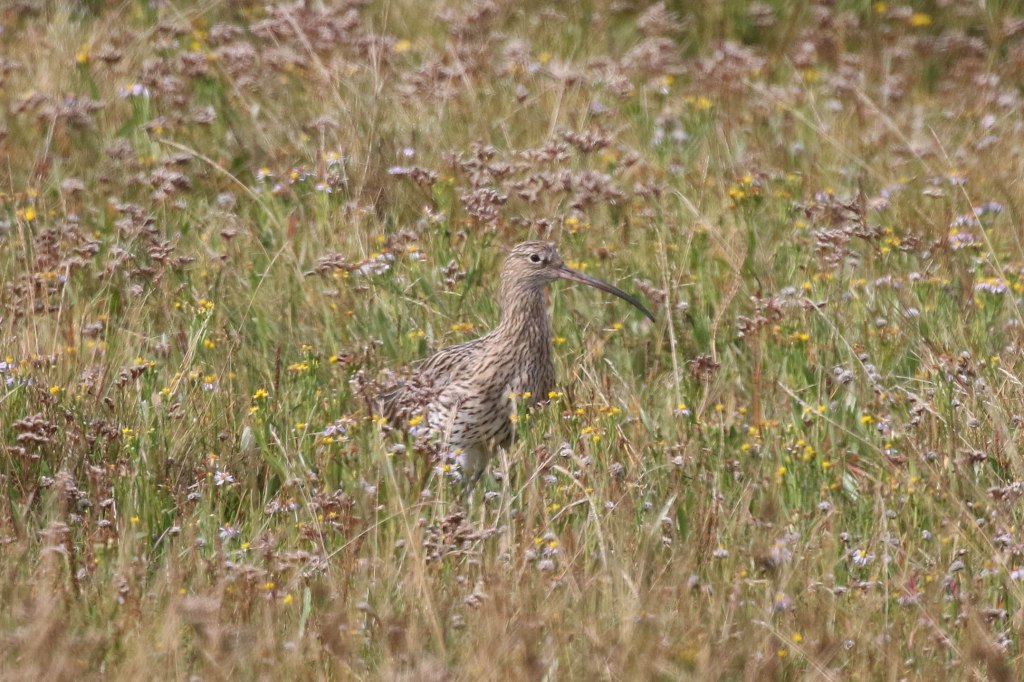
It was a nice still day, so when we heard Bearded Tits calling we scanned along the new edge of the water opposite where the diggers have built the new bank and quickly found a smart male in the reeds. We got it in the scopes, a great view as it came out into the open, picking around the floating vegetation disturbed by the digger. When the first disappeared back in, another male appeared a bit further back. A female appeared too and when they finally flew across the water and disappeared into the reeds the other side of the bank, we could see there were four Bearded Tits together.
A scan of the Reedbed Pool revealed a few more ducks – a couple of Shoveler, a single Tufted Duck and a large raft of Common Pochard. Two Little Grebes swam across in front. We could hear more Bearded Tits calling from the reeds a little further up, but they were in much thicker vegetation and remained well hidden. While we were looking, we heard something crashing through the reeds just below the path. We thought it might be an otter, so we waited by the pool just beyond, but nothing came out and it all went quiet.
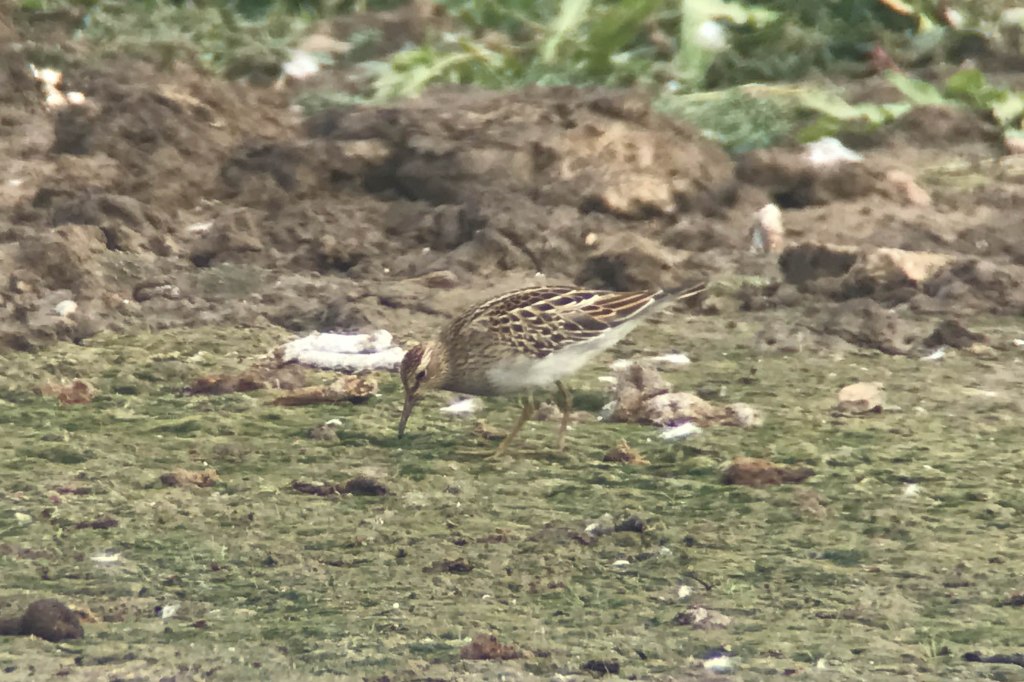
We were told the Pectoral Sandpiper was showing well from the path a little further up, beyond Island Hide, so we headed straight up there next. A small group of waders came up from the middle of the Freshmarsh and we turned to look at them as they flew towards us and on past – four Little Stints and two Dunlin! Unfortunately, they disappeared off west before the rest of the group caught up, having stopped to look at something by Island Hide.
The Pectoral Sandpiper was hard to see, picking around in the ruts in the mud left behind by the digger, but we got it in the scopes and eventually everyone got a good look at it. A scarce visitor here, this bird, a juvenile, will have been raised in either far NE Siberia or North America this summer and should be on its way to South America for the winter!
The weather was so nice, we decided to scan the Freshmarsh from up here, rather than head back into the hide. There were lots of other waders here, so we set about working our way through them. The Ruff were in various shapes, sizes and colours just to confuse the unwary! The Wood Sandpiper flew out from the edge of the reeds but unfortunately didn’t stay very long, before disappearing back in.
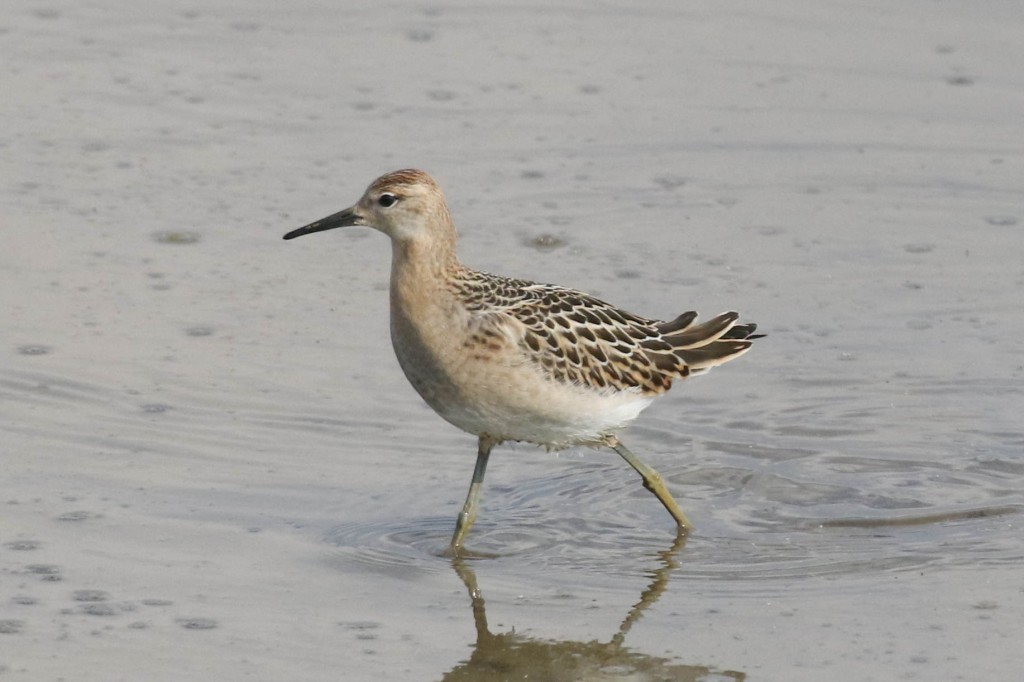
Further back, we could see a large flock of Black-tailed Godwits roosting and scanning through we found a couple of Bar-tailed Godwits in with them, juveniles with very strongly patterned upperparts. A small flock of Knot flew in and landed with them too and we managed to find a single juvenile Dunlin on the mud nearby.
Several Golden Plover were roosting on the new islands, surprisingly hard to see against the bare mud, but beautifully golden-spangled in the sunshine through the scopes. There were a few Lapwing on there too. Further back, we got the scopes on a small group of Avocets. There were several Common Snipe on the mud over in front of the reeds and a Greenshank flew in calling over Thornham saltmarsh right past us, before dropping down on the middle of the Freshmarsh.
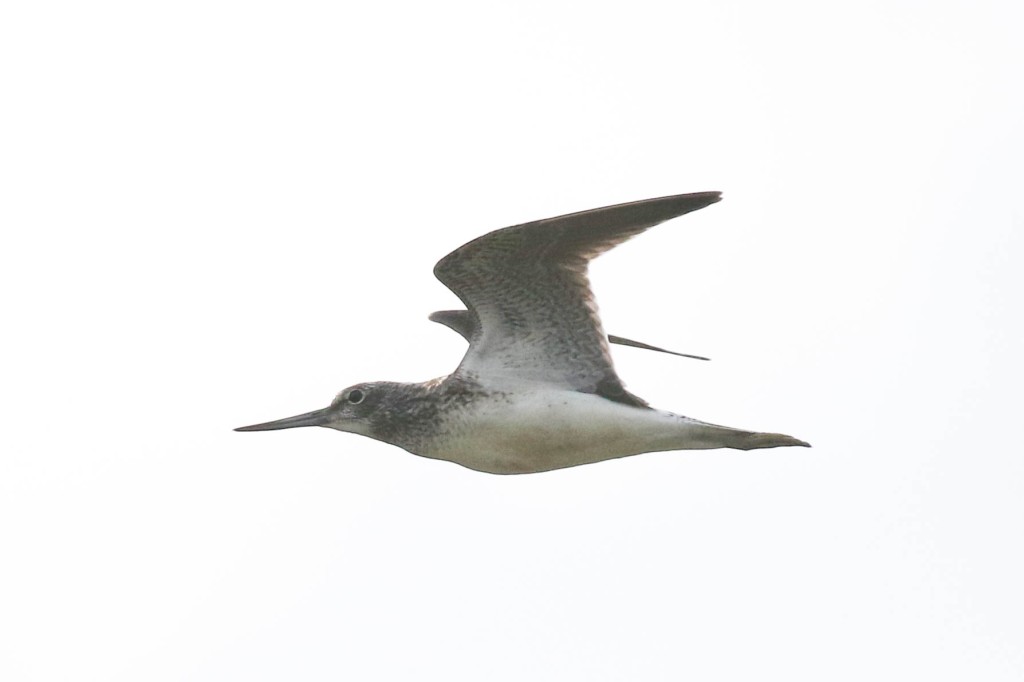
We dabbled briefly in the dark arts of gulls too, getting the scopes first on a couple of Common Gulls preening in with the roosting Black-headed Gulls, then comparing and contrasting an adult Lesser Black-backed Gull with a nearby adult Herring Gull.
We decided to head on out towards the beach next. There were just a few Curlews and Redshanks in the muddy channel at the far end of Volunteer Marsh, but there were a lot more waders on the Tidal Pools. With the tide coming in out on the beach, they had come in here to roost. A large group of Redshanks were loafing at the back before the bank and just beyond there were lots of Oystercatchers in the vegetation and a tight mass of Knot all down the nearby spit. A Turnstone was feeding nearby, flicking over lumps and mud and vegetation (rather than stones!) to look for food.
A big flock of Linnets kept flying up out of the suaeda bushes on the bank, flying round bouncing up and down, before landing back in the tops of the bushes. A male Stonechat flew in and landed with them.
The tide had already covered the mussel beds out at the beach. We got the scopes first on three Sanderling running along the edge of the waves just to the west of us. Three Ringed Plovers were on the shore the other side, towards Brancaster, but were repeatedly flushed by a dog and flew back towards us. There were still a few Oystercatchers and Turnstones out on the beach too.
While we were looking at the waders, one of the group scanned the sea and quickly located two Red-throated Divers just offshore. One was still largely in breeding plumage, still sporting its red throat, though it was hard to see with a bit of mist still lingering offshore. There were a few Sandwich Terns flying back and forth offshore too and a distant Gannet.
We picked up a single Brent Goose flying west well offshore first, followed shortly after by seven more Brent Geese with a single Wigeon, and then a much larger flock of Wigeon. These are the first Brent Geese of the winter we have seen – birds arriving fresh back from Siberia as we watched – and the ducks were also just coming back for the winter too. Always nice to see migration in action!
There were some rather threatening clouds to the west of us and we felt a couple of drops of rain, so we decided to walk back so we were closer to cover if it did come over our way. As we got to the turning to Parrinder Hide, the Wood Sandpiper flew in and landed in the corner of the Freshmarsh right below us. We had a great view of it now, as it fed in the small pool on the edge of the reeds, with both adult and juvenile Ruff for comparison.
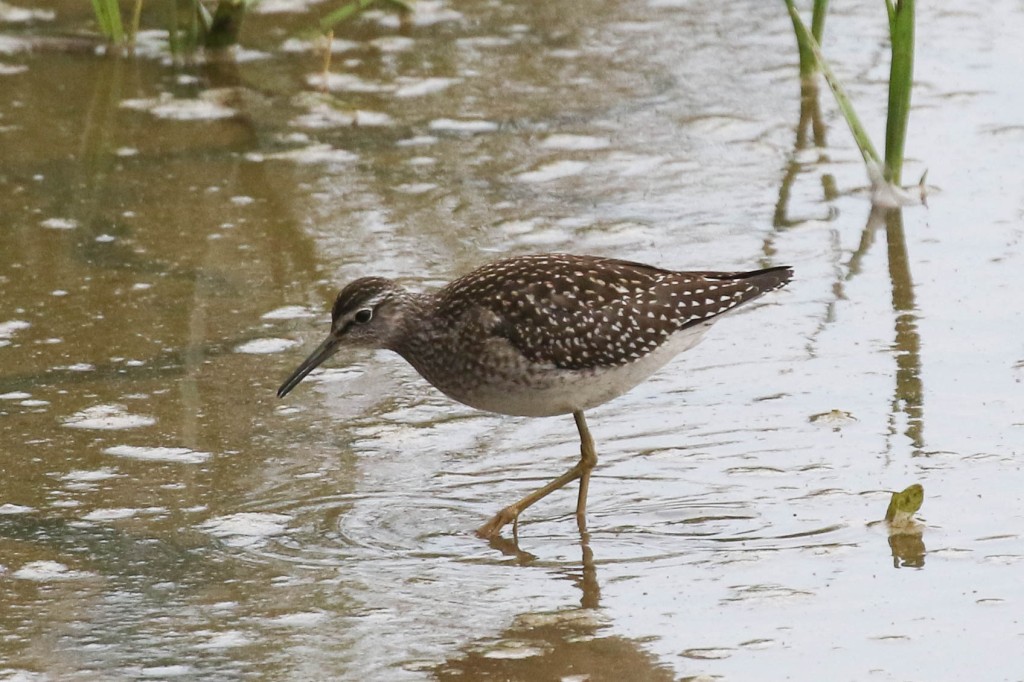
Scanning the the mud further back, we couldn’t see the Pectoral Sandpiper where it had been earlier, but we did find two Yellow Wagtails feeding around the margins, which we got in the scopes. A little further on, we relocated the Pectoral Sandpiper now out on the mud on the edge of the reeds from Island Hide feeding with the Common Snipe. A second Greenshank flew in over the saltmarsh calling, with the first answering from where we had seen it land earlier. A flock of seven Avocets came up from the Freshmarsh and circled up higher before turning and flying off towards the sea – just going off to feed somewhere else or perhaps heading off south for the winter? Hard to tell, but there are definitely birds on the move at the moment, as we had seen today.
With things coming and going all the time, we could have stayed here all evening, but unfortunately it was time now to call it a day and head back.
















